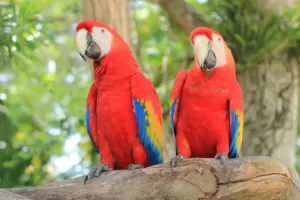Red parrots are undeniably striking, especially in combination with other magnificent colors that adorn their bodies.
Parrots with entirely red plumage are a rare sight, but their distinct shades are just as gorgeous and add to the uniqueness of their appearance.
Discover the most beautiful parrots with bright red plumage, from shades of crimson, and ruby to deep red and scarlet.
Quick Navigation
Types Of Red Parrots
Here are 20 beautiful red parrot species:
Scarlet Macaw
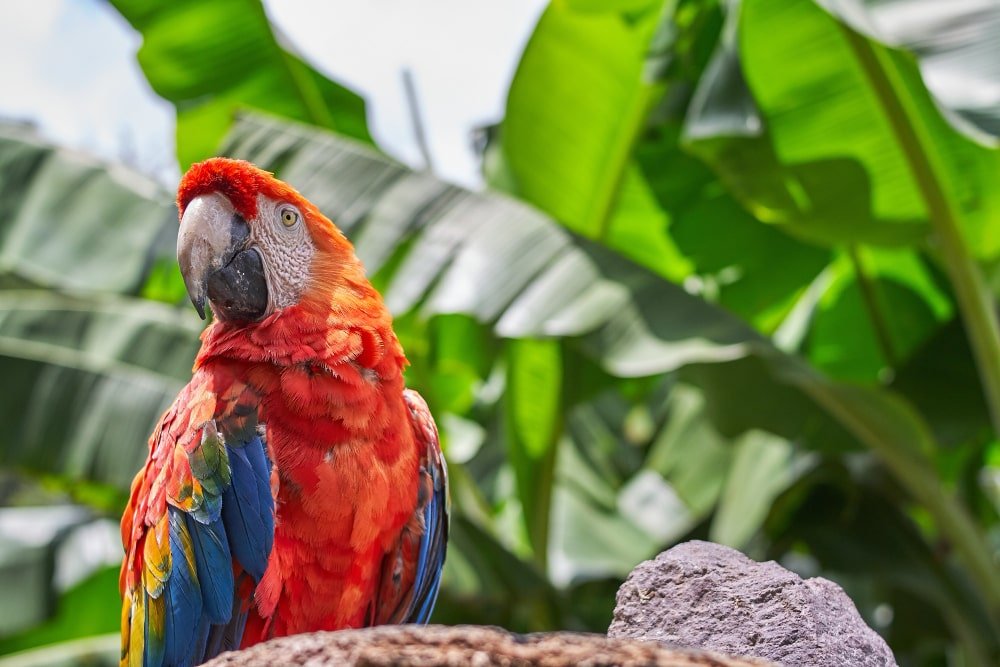
The large size, attractive colors, and charming personality of the scarlet macaw make it one of the most popular birds among enthusiasts. The primary plumage color of the scarlet macaws is bright red with blue, green, and yellow on the wings and tails. They have blue primary feathers and rump and yellow secondary feathers with green edges.
They are intelligent birds with big personalities, though they have a tendency to get attached to one person. Even when tamed, these birds can be bossy and sometimes bite, which is why it is best for an experienced person to handle them.
Red-And-Green Macaw

Found in the woodlands of northern and central South America, the Red-And-Green Macaw is the second largest parrot in its genus measuring 35 to 37 inches. The Red-And-Green Macaw has predominantly red plumage with blue primary feathers and some green sprinkled on the secondary coverts.
In the wild, red and green macaws inhabit lowland forests and their diet comprises seeds, nuts, fruits, and flowers. These birds are not for novice owners and their large size and shrieking voice can be quite intimidating.
Female Eclectus
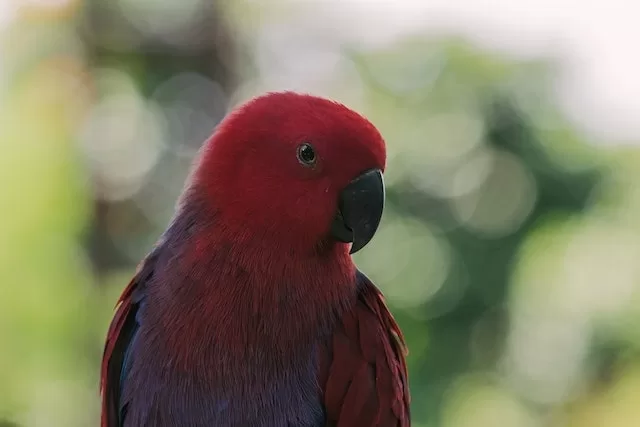
Eclectus parrots are a sexually dimorphic species of parrots, meaning that there are visual differences in appearance between the two sexes of the bird. The female Eclectus parrots are deep to bright red in color with violet abdomens and purple markings on their underwings and tails. The male eclectuses on the other hand are bright green with an orange beak.
Like their color differences, the males and females also differ hugely in personality. While the Eclectus parrot species is considered to be calm and friendly, the female Eclectuses are relatively aggressive and prone to nesting behavior. They are also prone to chewing furniture so they need a lot of toys for stimulation.
Red Lory
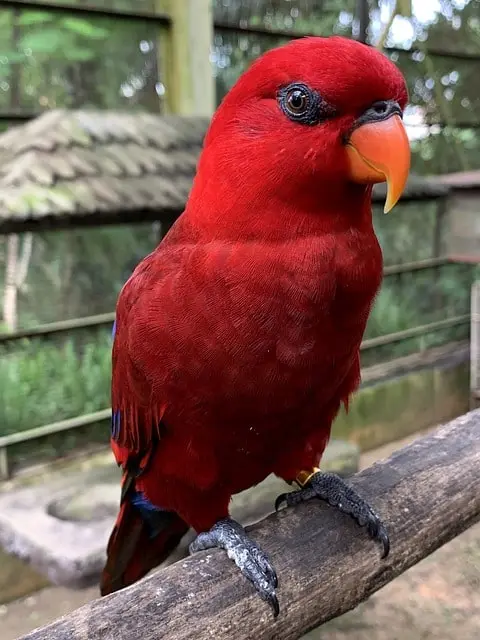
The red lory is a brilliantly colored bird with scarlet plumage, and splashes of blue on its wings. It also has reddish-brown tails with blue under-tail coverts.
Red lories are native to Moluccas and surrounding islands in Indonesia but they have been adopted as pets around the world for their fun-loving nature. In fact, red lories are the second most commonly kept lories after the rainbow lorikeets.
Red lories are energetic and playful birds and often mischievous too. They are chatty and moderately noisy, which is a good combination for any bird. However, they are quite raucous in that they occasionally make shrill vocalizations and tend to be quite destructive with their toys.
Chattering Lory
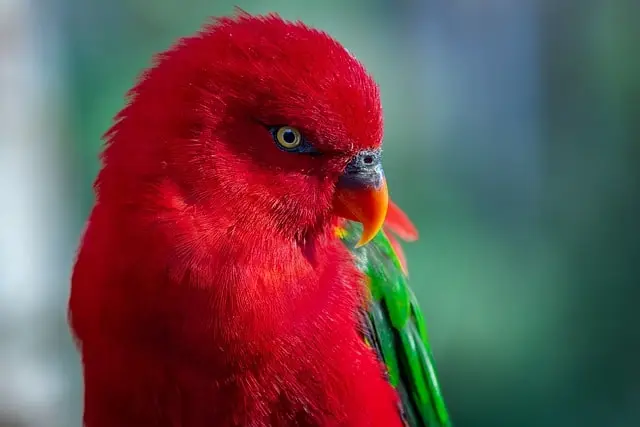
The chattering lory is mostly deep red with dark green wings and splashes of yellow on the shoulders and upper back. They’ve been given the name “chattering lory” so they’re obviously not a quiet bird.
Chattering lories make frequent vocalizations and high-pitched screams, which can get extremely loud. However, as is the case with most loud parrots, the chattering lories are talented talkers. These parrots have decent talking ability and can memorize and repeat words, phrases, and sounds.
When it comes to care and time commitment, lories are generally quite demanding. They need a lot of attention from their owners and are always ready to go because they are so high energy.
They also require a specialized diet of pollen and nectar mix and eat large volumes of food because their diet is high in moisture content. They are not apartment birds and require a lot of out-of-cage time to burn those calories.
Red And Blue Lory
The Red-and-blue Lory is a beautifully colored parrot that’s endemic to the Karakelong island in Indonesia. The red-and-blue lory is mainly red in color with blue hues distributed across its back, wings, and parts of the face.
It has a wide stripe of blue on its chest and a blue band that runs across its eye to its ear coverts and its crown. The wings and tail flight feathers are between are red with black tips. The Red-and-blue Lory is an endangered species and faces major threats from habitat loss and wild bird trade.
Blue-eared Lory
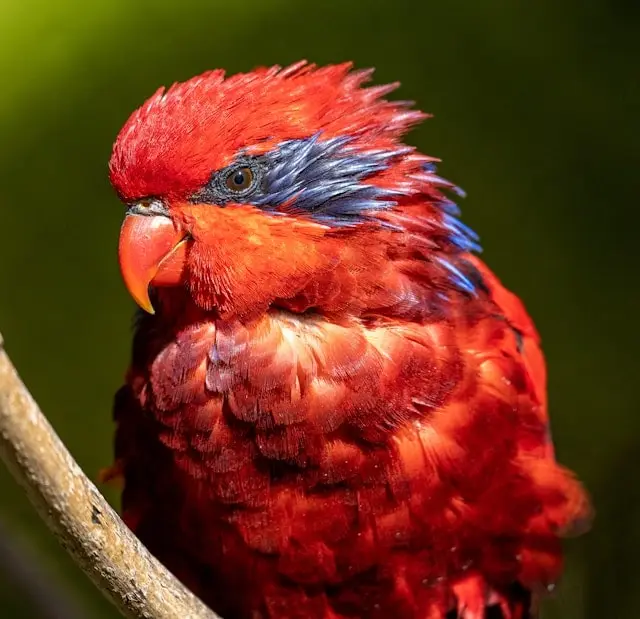
The Blue-eared Lory looks strikingly similar to the red and blue lory. It has a bright red plumage with blue on ear coverts and under the eyes. It also has blue on its scapular feathers, lower abdomen, and thighs.
The Blue-eared Lory prefers higher altitudes and is generally found above 4000 ft. The species inhabits montane forests and montane heathlands. These birds are known to make loud and screechy calls while flying. The population of blue-eared lories is starting to decline due to trapping for bird trade.
Blue-Streaked Lory
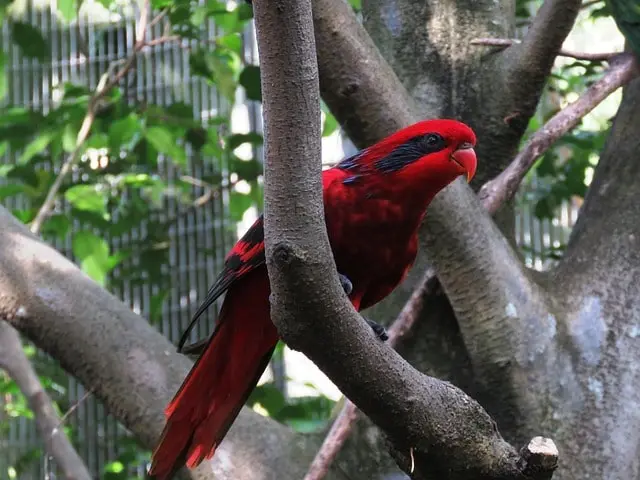
The Blue-Streaked Lory is one of the most stunning birds with shiny red feathers and iridescent blue streaks. The blue streaks run across the eyes and ear coverts to the upper back. The flight feathers are red with black tips and the tails are bluish-black
Blue-Streaked Lories are inquisitive and comical. They are fun-loving and always ready for playtime. However, like other lories, they make loud squeals and are socially demanding. They need a lot of attention to keep them mentally stimulated and happy.
Violet-Necked Lory
The Violet-necked Lory has a mostly red plumage with a wide blue stripe around its neck. The wings are red with black on the outer flighter feathers. The width of the neck stripe varies based on the individual and subspecies. The violet-necked lory has three subspecies: E.s. squamata, E.s Riciniata, and E.s Obiensis.
Their diet in the wild consists of nectar from Erythrina flowers and flowering sago palms. They also eat fruits and insects. They have a small and noisy flock of up to 10 birds and travel across the island in search of feeding sites.
Purple-Naped Lory
Purple-naped lories are characterized by a diverse mix of plumage colors. Their overall plumage is predominantly red, with a purple patch extending from the forehead to the occiput. The upper breast features a thin stripe of yellow feathers. The thighs are shades of purple and blue, while the wings are colored with rich forest green.
They also have yellow underwings and tails tipped with darker brown or red tones. The bill is a vibrant orange, complementing the overall vivid appearance. Completing the colorful look, the eye-ring is dark grey, and the eyes themselves are orange color.
The Purple-naped Lory is found in the forests of Wae Fufa on the island of Seram, Indonesia, at elevations exceeding 700 meters. These parrots have a diverse set of vocalizations, including a distinctive musical whistling call and a harsh braying call reminiscent of the Salmon-crested Cockatoo.
Black-Winged Lory
The Black-winged lory boasts a vibrant red plumage with black scapulars and tertials and violet streaks that run from the eye to the ear coverts.
They are intelligent and outgoing parrots with a charming personality. They are also goofy and have a bunch of playful antics that keep everyone entertained. However, Black-Winged Lories are not as popular as pets compared to other lories.
The black-winged lory is currently listed as near threatened, but its population has been on a continued decline and is suspected to become threatened in the near future.
Black-Capped Lory
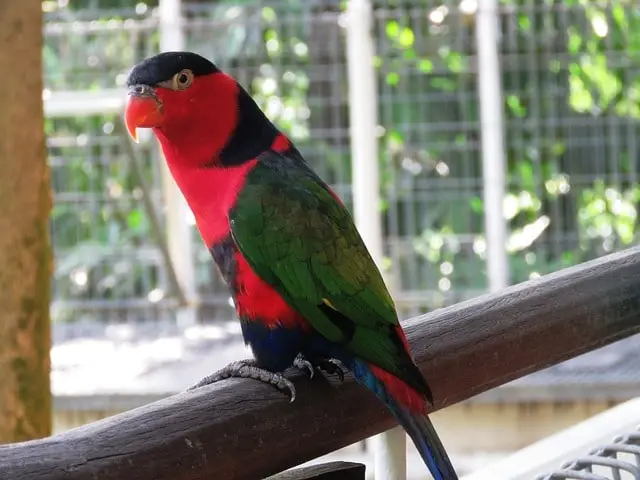
Bold, boisterous, and loud, the Black-Capped Lory is one of the favorites of the lories among bird fanciers. The black-capped lories are beautiful-looking parrots native to New Guinea. They have an array of colors on their body and they are also called the tricolored lory.
Black-capped lories are mostly red with a distinctive black crown and an orange beak. The back of the neck is covered by a band of blue feathers that reaches to the sides of the neck. The wings showcase a shimmering bronze-green color while the lower abdomen, thighs, and undertail cover are marked by a deep dark blue hue. They also have yellow on the underside of the wings.
There are seven subspecies of the black-capped lory and each of them has a slightly different arrangement of feather colors, separating them from each other.
Cardinal Lory
The Cardinal Lory sports an all-red plumage with an orange beak and black eyerings. While it is entirely red, the wings exhibit a darker shade of red, comparable to reddish-brown.
They are highly active birds that find funny and creative ways to expend their energy, like jumping up and down or pacing in their cage. These birds require spacious accommodation and plenty of time out of the cage to exercise and stay active.
Cardinal Lories are friendly birds for the most part, but they can sometimes be nippy. They are not suitable for new bird owners due to their eccentric behavior and specialized care requirements.
Crimson-Bellied Conure
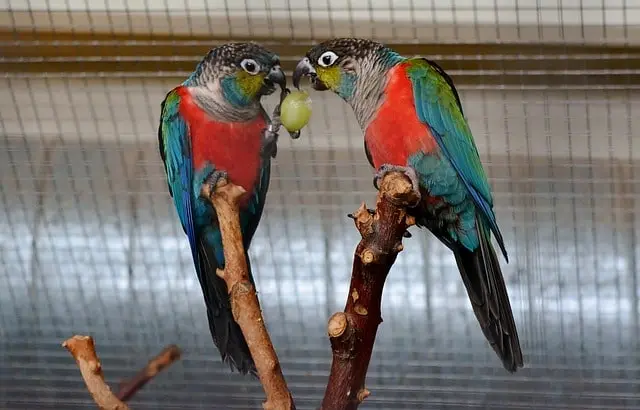
The crimson-bellied conure is a species of conure originating in Bolivia and Brazil. They are recognized for the large red patch of feathers of their bellies. They have green cheeks, greenish-blue wing feathers, and an off-white upper chest.
Due to their vibrant coloration, they are a sought-after conure species, but they are a challenging bird to own. Crimson-bellied conures tend to be loud and sometimes aggressive. Their body language is harder to read, which makes it difficult to anticipate changes in their behaviors. They also have stocky beaks and can be quite hard.
However, it’s not all bad with the crimson bellies. When they are bonded to their human companions, they can be very cuddly and gentle birds. Crimson bellies conures are also good talkers learning short to long phrases.
Crimson Rosella
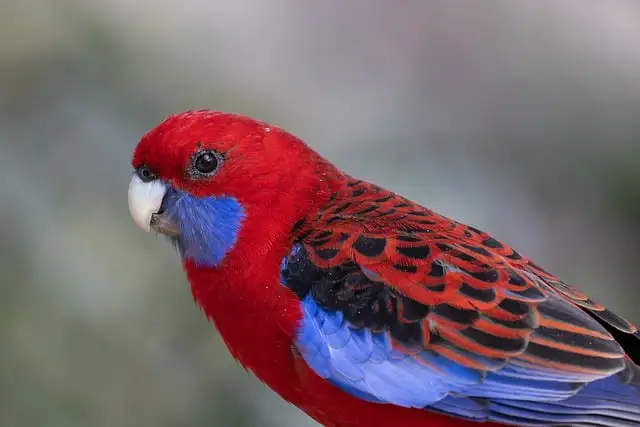
The crimson rosella originates in eastern and southeastern Australia and commonly inhabits woodlands and mountain forests. The crimson rosella has an iconic deep red color splashed with bluish-purple hues on its throats, outer wings, and tails. It also has black scalloped markings on its back.
These parrots are a bit shy and can be flighty and easily spooked when starting out. But once the bond is established, they can be very affectionate and loyal towards their owners.
Crimson rosellas are relatively quiet birds, occasionally having loud spurts. They mostly make gentle vocalizations that are pleasant to the ears and as such they are great for apartment living. However, they are not particularly skilled at talking and mimicking.
Western Rosella
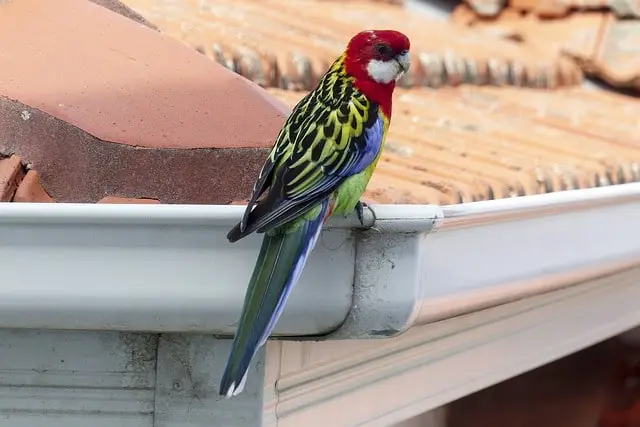
The western rosella is another amazingly colored species of rosellas found in southwestern Australia. The Western Rosella is a sexually dimorphic species, so the males and females have different coloration.
The male Western Rosella has a red body with yellow cheek patches and greenish blue wing feathers and tails with mottling of black.
The female Western Rosella on the other hand exhibits a more subdued appearance with a dull red forecrown. The crown and sides of the neck are green, and the cheeks are covered with yellow patches. The female’s underparts are primarily green, washed with a muted red hue.
As pets, they are calm and easygoing with a friendly personality. Their vocalizations are mostly soft, though they may belt out a few louder screams occasionally. They have decent talking ability and can only learn small words and sounds.
Golden-Mantled Rosella
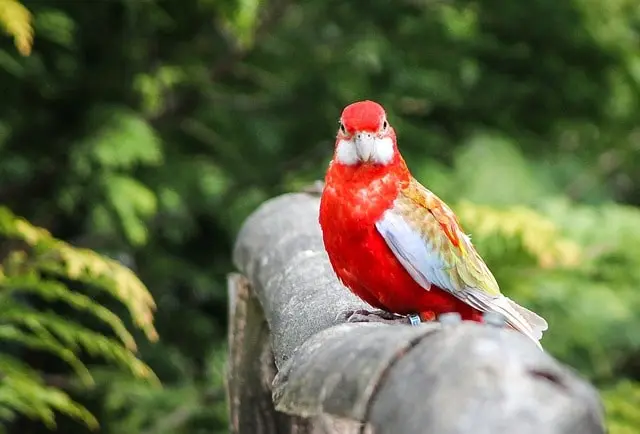
The Golden-Mantled Rosella also known as the eastern rosella, is another commonly kept rosella in captivity. These birds are adored for their vivid colors and fun personalities. The Golden-Mantled Rosella is characterized by a red head and breast, white cheeks, and a yellow underside. The back is yellow spotted with black and the outer wings and tail feathers exhibit blue colors.
The golden mantled rosellas are not known to be cuddlers but they do show their love in other ways such as climbing up your shoulders or head. Well-tamed rosellas make wonderful pets for the family as they enjoy the company of everyone and do not get attached to one person.
Australian King Parrot
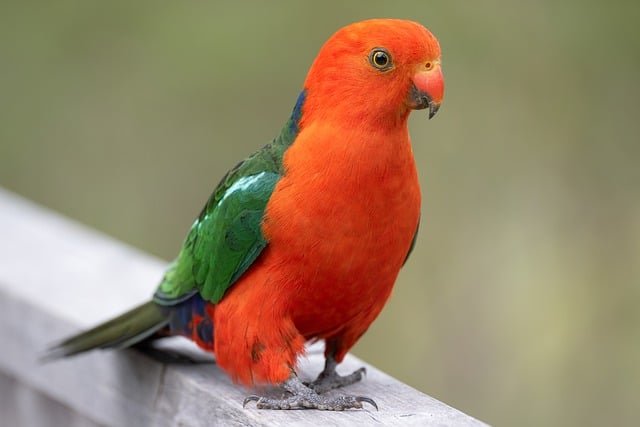
The Australian King Parrot is a medium-sized parrot native to eastern Australia. They are sexually dimorphic, meaning the males and females can be distinguished based on their physical look.
The only difference between the two is their head feather colors. The males have red-colored heads while the females have green heads. A red belly and a green back, wings, and tail are common among the two genders.
Australia King parrots make quiet and docile household pets when handraised. However, like all quiet birds, their talking ability is not very polished.
Moluccan King Parrot
The Moluccan king parrot has predominantly red feathers with dark green wings. They also have blue on their shoulders and back and a long blue tail. They have six subspecies so the plumage colors can have variations based on the species.
Moluccan king parrots are gentle and even-tempered and make excellent companions. However, they are quite uncommon in captivity.
Papuan King Parrot
The Papuan king parrot has a mix of several different colors on its feathers. It has red head and undersides, green wings, and blue tails. This species is native to New Guinea and inhabits dense forests and cultivated areas. They fly in small groups in the wild and remain inconspicuous while feeding.
